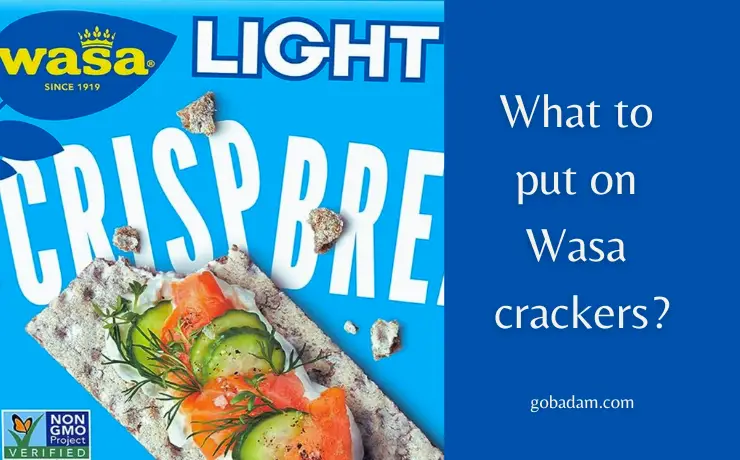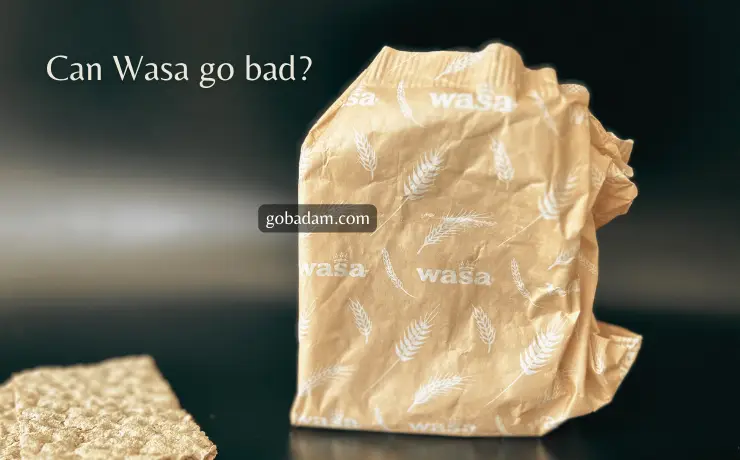Do Wasa crackers go bad? Ah, the age-old question for the connoisseur of crunchy delights! Whether you’re stacking them with avocados or savoring them solo, the longevity of these wholesome crisps is a curiosity worth crunching down on.
From understanding the nuances of their shelf life to being a hawk-eye for signs of spoilage, storing your Wasa wonders correctly ensures they remain as mouth-wateringly delicious as intended.
But fear not, dear cracker aficionado, as we embark on a tasty trek through the world of Wasa – exploring the secrets of storage, the telltale signs of staleness, and the ins and outs of ensuring every bite is as yummy as the first!
Do Wasa crackers go bad?
Yes, Wasa crackers can go bad. To maximize freshness, store them in a cool, dry place and keep them sealed. Check for signs of spoilage like mold, off-odors, or staleness. Always adhere to the best-by date for optimal taste and quality.
You can read about how to keep them fresh, Wasa crackers spoilage signs, storage tips, and more below.

How long does Wasa last?
Wasa crackers have a one-half-year shelf life since the production date without opening. According to the producer, Wasa itself, Wasa crackers have a long lifespan.
It is, actually. Because many crackers’ lifespan is shorter than Wasa crispbreads. Wasa crackers have a very significant baking and making process. It is obvious that they care about its content and varieties as much as its production. You can find many types of Wasa and consume whatever you want according to your taste.
PURCHASE 👉🏻 wasa crispbread

Do crackers expire if unopened?
Yes, crackers can expire even if unopened. Over time, they can lose their freshness, taste stale, or have reduced nutritional quality. Especially when combined with ingredients that are more perishable, their chances of spoiling quickly may be higher compared to the plain version.
While they might still be safe to eat after their expiration or “best by” date, the flavor and texture may be compromised. Always check the package for expiration dates and store in a cool, dry place to maximize shelf life.
How long do crackers last unopened?
The shelf life of unopened crackers largely depends on the type of cracker and its ingredients, as well as the storage conditions. Generally, unopened crackers can last:
- Regular Crackers (e.g., saltines, Ritz): 6-9 months past the date printed on the package.
- Whole Grain Crackers: 5-6 months past the date on the package, as they contain oils from grains and seeds that can become rancid.
- Gluten-free or Specialty Crackers: Varies, but typically around 4-6 months. Always check the expiration date as some might have a shorter shelf life due to unique ingredients.
- Rice or Corn Crackers: Often have a longer shelf life, up to 12 months.
To ensure maximum freshness, store unopened crackers in a cool, dry place away from direct sunlight. Always refer to the product’s packaging for the most accurate shelf life information.
How long are crackers good for after opening?
After opening, crackers are exposed to air, moisture, and other environmental factors that can impact their freshness. Typically, opened crackers can last:
- Regular Crackers (e.g., saltines, Ritz): 1-2 weeks for optimal freshness. They might still be safe to eat after this, but they’ll likely start to taste stale.
- Whole Grain Crackers: About 1 week. The natural oils in whole grains can turn rancid over time, especially when exposed to air.
- Gluten-free or Specialty Crackers: Varies, but generally around 1 week. Some may have a shorter or longer freshness window due to their specific ingredients.
- Rice or Corn Crackers: 2-3 weeks, as they tend to be less prone to going stale quickly compared to other varieties.

Spoilage signs of Wasa crackers
Wasa crackers, like many other dry food items, have certain signs that indicate spoilage. Here are some signs that your Wasa crackers may have gone bad:
- Change in Taste or Smell: If they have an off or rancid smell, it’s a clear indication that they have gone bad. A stale taste is also a sign of aging crackers.
- Mold Growth: While it’s rare due to the dry nature of the crackers, any visible mold or discoloration suggests contamination.
- Texture Change: Wasa crackers are typically crisp. If they feel soft, and spongy, or have lost their crunch, it could be a sign of moisture infiltration and potential spoilage.
- Presence of Pests: Any signs of pests, like insects, or their droppings in the packaging are a clear sign of contamination.
- Expired Best-by Date: While not a definitive sign of spoilage, it’s a good practice to consume food products by their recommended best-by or use-by date to ensure optimal quality and safety.
- Damage to Packaging: Compromised packaging can lead to external contaminants getting inside, increasing the risk of spoilage.
How to store Wasa crackers?
Storing Wasa crackers properly will help maintain their crispness and freshness for longer. Although everyone’s methods and opportunities are different, let’s look at ways to keep our Wasa crackers fresh, based on some common solutions.

Best Way to Store Wasa Crackers
Here are the basic and best ways to store Wasa crispbreads. Follow these methods and enjoy eating your crackers as fresh as they were on the first day.
Original Packaging
If you haven’t opened the package, store it in a cool, dry place away from direct sunlight. Once opened, roll the top of the bag down tightly to remove as much air as possible, and then seal it with a clip or rubber band.
I generally use IKEA food clips in my kitchen. I have tried many different brands before, but this is the one that I have been able to use for the longest time and was most satisfied with.
See offer 👉🏻 ikea food saver clips
Wasa Cracker Container
Transferring opened Wasa crackers to an airtight container can be even more effective in keeping them fresh. This method helps to protect the crackers from both moisture and air, which are the primary culprits behind staleness.
See offer 👉🏻Wasa crispbread storage container
Cool, Dry Place
Regardless of the container, it’s essential to store your Wasa crackers in a cool, dry place. Avoid close proximity to sources of heat and moisture, especially in the kitchen.
See offer 👉🏻 kitchen storage cabinets
Avoid Humidity
Moisture is the enemy of crisp crackers. In very humid environments, consider using food-safe desiccant packs to absorb excess moisture in the container or storage area.
Check for Seal Integrity
If you’re using a container, periodically check its seal to ensure that it remains airtight. Over time, seals can weaken or degrade, allowing air and moisture to enter.
Long-Term Storage
If you’ve purchased Wasa crackers in bulk and won’t consume them soon, you can consider storing them in the freezer. While they don’t freeze solid due to their low moisture content, this method can extend their shelf life. Just ensure they are in a sealed, airtight package or container.
Rotate Your Stocks
If you purchase Wasa crackers regularly, practice the “first in, first out” method. Consume older packages first to ensure you’re always eating the freshest crackers.
By following these storage tips, you can enjoy fresh and crunchy Wasa crackers for longer. Always check for signs of spoilage before consuming and trust your senses if something seems off.
What to put on Wasa crackers?
Last but not least, healthy Wasa crackers definitely will be more yummy with other nutrients as well. Dip sauces such as tahini (learn what is tahini) are especially popular and go well with Wasa crispbreads. I generally prefer to mix tahini with molasses (you can read can molasses go bad or not).
Healthy options such as peanut butter, almond butter, blueberries, and mild cream cheese will also add delicious flavors to your Wasa bread. Additionally, those who want to eat healthy can also consider drinking Kombucha with their food.
If you like to eat Wasa bread with desserts for breakfast, honey, and its derivatives may also interest you. I prefer honeycomb honey as it is healthier. Here you can find more detailed information about honeycomb honey and does honeycomb expire or not.
If you have run out of Wasa stock or are consuming bagel bread instead of Wasa crackers, you can find storage tips, signs of spoilage, and other details on how long do bagels last.

Frequently Asked Questions About Do Wasa Crackers Go Bad
Here are top questions about do Wasa crackers go bad and more. If you have anything to share, feel free to contact me.
Can you eat out of date crispbread?
Yes, you can typically eat out-of-date crispbread if it doesn’t show signs of spoilage. Most crispbreads have a “best-by” date, indicating quality rather than safety. Before consuming, inspect for mold, off-odors, or staleness. Proper storage in a cool, dry place extends freshness. Always trust your senses; if something seems off, it’s best to discard it.
Is Wasa whole grain crispbread healthy?
Yes, Wasa whole grain crispbread is considered healthy. They’re made from whole grains, high in fiber, low in sugar, and typically free from artificial additives. They’re also low-calorie and versatile, allowing for nutritious toppings. However, check specific varieties and ingredients on the label for the best dietary choices.
How long does Wasa crispbread stay fresh?
Stored properly in a cool, dry place and kept sealed, Wasa crispbread can stay fresh for several months, though consuming by the best-by date ensures optimal quality.
When exploring the shelf life of various kitchen staples, many often wonder: Can halva go bad? Similarly, questions arise about products like Can Tahini Go Bad? or condiments like Do Capers Go Bad? Even everyday items aren’t exempt from such inquiries, prompting questions like Does Pasta Go Bad?, Does Cornstarch Go Bad?, Does Honeycomb Expire?, Does Halloween candy expire?, Does Kit Kat expire?, and How Long Do Bagels Last?“


